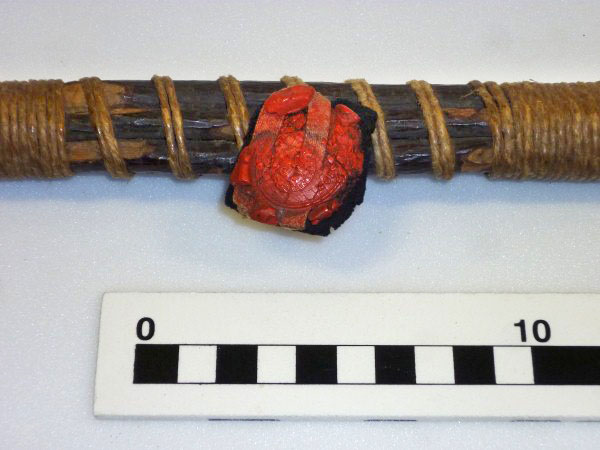19th century
Birch Rod
A 19th century birch rod used in prisons to discipline male prisoners has been documented in the Irish Folklife collections.
By Noel Campbell
The object consists of fifteen rods 93cm long and tied together with twine. The tied part forms the handle which is 55cm long. The rest is left loose and forms the beating end. This is 35cm long and roughly round in section, 7cm in diameter. Attached to the handle is a cracked wax seal with the only visible lettering being ‘sion’, possibly the end of the word ‘commission’ and what appears to be the British coat of arms on it.

Figure 2: Wax seal attached to the handle (F:1966.60)
Another wax seal was once attached and along with the lion rampant read “General Prisons Board, Ireland” and the words “Dieu et mon droit”.
Where does it come from?
The rod was originally in the possession of the General Prisons Board, Ireland and came to the National Museum of Ireland through the Department of Justice. The management of the Irish prison system passed to the control of the Minister for Justice with the dissolution by statutory instrument of the General Prisons Board in 1928. The birch was acquired along with a cat o’nine tails from the same source.
What was the rod used for?
A label attached to the object reads:
“General Prisons Board, Ireland. Pattern of Birch Rod for Corporal Punishment of Male Convicts when required. Approved by Government per minute of 18 July 1894, 8362/94 G.H. Douglas Secretary”.
The General (Prison) Rules as Settled and Approved by the Lord Lieutenant and the Privy Council on 29th August 1882 set out clear guidelines for corporal punishment of male prisoners. Offences which could see a prisoner receive the birch or cat o’ nine tails included mutiny in a prison, violence or threats of violence, offensive language used to any officer or servant of the prison, destruction of prison property, interrupting the order and discipline of the prison and any misconduct requiring to be suppressed by extraordinary means. An inquiry upon oath was held into a case before punishment was delivered.
The number of lashes was restricted to 36 for an adult and 12 for a juvenile prisoner. Adults were beaten with either the birch or cat o’ nine tails but juveniles were only to receive the birch rod and all instruments were to be previously approved by the General Prisons Board. The Medical Officer determined whether prisoners were in a fit state to receive punishment, they also attended the lashing and could intervene at any stage if they felt the prisoner’s health was in danger.
Learn more...
The rod is stored in the Museum’s reserve collection in Turlough Park House, Castlebar, Co. Mayo and is not currently on display to the public.
The rod and similar objects regarding Law and Order on the island of Ireland over the last two hundred years feature in the Preserving the Peace exhibition at National Museum of Ireland - Country Life.
Location:
Birch Rod is located at:
In Storage
Previous artefact:
Bianconi Pre-Rail Travel in Nineteenth Century Ireland
Next artefact:
